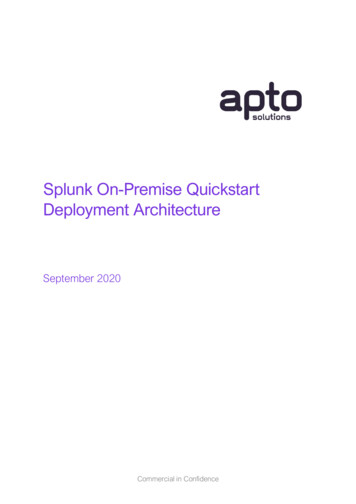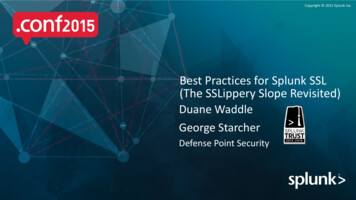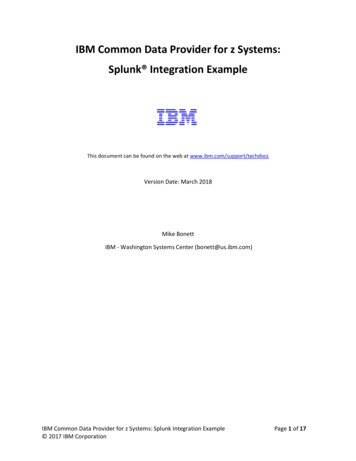
Transcription
Splunk On-Premise QuickstartDeployment ArchitectureSeptember 2020Commercial in Confidence
IntroductionThis document provides a high-level introduction to Splunk terminology, operation andconsiderations for on-premise deployment, to allow basic architecture options to bediscussed and agreed with a customer.General Requirements for SplunkSplunk architectureYour Splunk system should be implemented in-line with Splunk’s recommendedarchitecture patterns to ensure that you get the best performance, scalability and valuefrom your solution from day one.The range of configuration options and approaches are available online unk-validated-architectures.pdf,however this document provides a distilled set of considerations for a typical newSplunk user with low to moderate data volumes.Scalability considerationsSplunk installations can be architected and scaled to range from a single standaloneserver to a multi-clustered, tiered configuration split across global data centres. This issupported by separating the different types of Splunk functionality across different tiers.A single standalone server could be used for small solutions (under 50 GB/day)however it then becomes difficult to scale from there as your Splunk data volumes anduse cases increase.Standalone server – quick and easy configuration for upto 50GB/day and small numberof users. However this is difficult to scale, data may be lost if the server is down or toobusy, and end-user performance competes with Splunk processing for CPU cycles.Hence the need to consider a multi-server installation.The three tiers of functionality within Splunk are:Commercial in Confidence
FORWARDERS. These are Splunk components installed on yourinfrastructure, that gather and send data from that instance to the INDEXERtier. Typically, a lightweight Universal Forwarder (UF) is installed on eachserver/desktop/device that is to be monitored. In some cases, additionalinstallations of FORWARDERS may be needed on further Splunk servers, tocollate and optimise data delivery across forwarders to the Indexer tier.INDEXERS. This is the data storage tier, that receives, indexes and storesdata and supports the SEARCH tier. The indexer tier consists of one or moreinstances, sized to handle the data storage workload. Additional instancescan be added to form a cluster that provides redundancy and high availabilityof the data.SEARCH Heads. The SEARCH tier provides the front-end UI – reports,dashboards, alerts. Again, this tier needs to be sized and scaled accordingto the number of users, number of reports/use cases and taking into accountavailability/DR requirements for the UI.In addition to these three tiers, a further Splunk instance known as a DeploymentServer is used to simplify the management of the whole Splunk environment. Thisensures that the configuration can be easily managed, changed and scaled asneeded across all Splunk instances. The DS manages each tier: Forwarders – these are configured to ‘call home’ to the DS periodically to getthe latest configuration information.Indexers – the index and index cluster information is managed from the DSSearch Heads – the Search head and cluster configuration is managed fromthe DSCommercial in Confidence
General environment requirementsA Splunk installation requires some specific infrastructure capabilities to be in place toavoid common potential pitfalls. Linux is the recommended OS, but Windows 64-bitCPU servers can be used.Commercial in Confidence
Splunk Server Recommended SpecificationsThese are the recommended specifications for the individual servers that will be usedwithin your Splunk installation to achieve the best performance throughput as datavolumes grow.Indexer minimum specificationTo avoid the loss of any data, INDEXERs need to be clustered for redundancy andavailability data is replicated across the instances, and also across Data Centres for DRcasescapacity of each instance depends on the spec of the individual servers: CPU data storageneed to size each server based on overall data volumes and number of datasourcesscaled for availability/reliability requirementsCommercial in Confidence
Indexer example specificationsThe Indexer servers should each be of the same specification so that they can operateequally within the cluster. The actual size and specification of each individual servershould be matched to the storage throughput that needs to be supported.Cluster Master (CM) SpecificationWhen an Index cluster is used, an additional lightweight server is needed to provide coordination across the cluster. The specification for a CM server supporting a 3-indexercluster would be as follows: Intel 64-bit chip architecture4 CPU cores at 2 GHz8GB RAMCommercial in Confidence
Search Head Reference SpecificationThe SEARCH tier provides front-end UI – reports, dashboards, alerts. Again, this tierneeds to be sized and scaled according to number of users, number of reports/usecases and taking into account availability and DR requirements.Deployment Server (DS) SpecificationThe specification for a DS server supporting an entry-level Splunk configuration with 1200 forwarders to be managed would be as follows: Intel 64-bit chip architecture4 CPU cores at 2 GHz8GB RAMCommercial in Confidence
Additional ConsiderationsSyslog IngestionA common requirement for a Splunk Enterprise deployment is to ingest syslog formatlog data from an open-source syslog consolidation server such as syslog-ng or rsyslog.In these cases, a Splunk Universal Forwarder will be installed on the syslog-ng server(s)instead of being installed on the source servers or appliances that generated the loginformation. It will forward all of the log data to Splunk.Another scenario where a syslog server is needed is where devices distribute their loginformation using UDP data, which is a potentially unreliable fire-and-forget protocol. Ifthis data were sent directly to Splunk and the Splunk server was unavailable for anyreason, the record could potentially be lost. To avoid this, the syslog server isimplemented with high availability, to receive and store syslog data. The Splunk UFthen forwards data to Splunk, using a guaranteed delivery protocol.Splunk provide an out-of-the-box syslog-ng Docker configuration named SplunkConnect For Syslog (SCFS) that can be deployed in a Docker container. If Docker isnot used by the customer, the Splunk configuration files from SCFS can be used withthe on-premise syslog-ng to implement a best-practice configuration.Commercial versions of syslog-ng are also available, if a fully 3rd-party supportedsoftware stack is required.Commercial in Confidence
Recommended Architecture for High-Availability LowVolume ( 100GB / day) Basic DeploymentThe recommended architecture for a Splunk RAP deployment is as shown below,consisting of: 3 x Indexer instances configured as a cluster to ensure data availability1 x Cluster Master (not shown in diagram)1 x Search Head to support use cases for up-to 10 users1 x Deployment Server to manage overall configurationThe standard specification for an Indexer server can handle up-to 300GB/day. For asituation with an overall daily ingestion of upto 200GB, spread across a cluster ofindexers, the specification of these servers can be reduced.Similarly if there a low number of Search users and/or search use-cases, the Searchhead can be reduced in specification.A suitable specification for an entry level deployment would be: Search Head: 8 CPU cores, 16GB RAMEach Indexer (3 off): 4 CPU cores, 8GB RAMCluster Master: 4 CPU cores, 8GB RAMDeployment Server: 4 CPU cores, 8GB RAMIn addition to the Splunk servers, syslog-ng syslog server may be needed. A 4 CPUcores, 8GB RAM server is sufficient for supporting an entry level Splunk deployment.This will have open source syslog-ng installed to collate syslog data from the agreeddata sources (as per agreed project data source register), and a Universal Forwarder tosend to the Indexer cluster.The Splunk data that is indexed is aged over time and the retention period for datadepends on the customer’s storage capacity and the need for searching on older data.Commercial in Confidence
As a guideline the estimated storage requirement for 25GB/day ingestion stored onthree indexers is as follows 30 days : 290 GB per Indexer60 days : 580 GB per Indexer90 days : 870 GB per IndexerCommercial in Confidence
This document provides a high-level introduction to Splunk terminology, operation and considerations for on-premise deployment, to allow basic architecture options to be discussed and agreed with a customer. General Requirements for Splunk Splunk architecture Your Splunk system should be implemented in-line with Splunk's recommended










